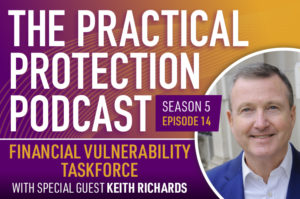The PPP - Financial Vulnerability Taskforce
Request a Callback
By clicking on submit I / We give consent for you to call me / us on the number provided to discuss my / our financial requirements.
Caring - Understanding - Reliable - Advice
Home » Guides & News » The PPP – Financial Vulnerability Taskforce

Financial Vulnerability Taskforce
Kathryn is joined by a special guest Keith Richards from The Financial Vulnerability Taskforce for episode 14 of the Practical Protection Podcast.
Keith has been working within the insurance industry for around 40 years, in various different roles. A key driver for Keith being a part of the financial vulnerability taskforce was to raise the profile of advice. This included introducing initiatives for the general public, as raising the profile of advice is no use unless the public know about it.
The financial vulnerability taskforce is a professional body that has been set up to help consumers and advisers better understand what exactly vulnerabilities are. A lot of people will face a vulnerability at some point through their lives and this became quite apparent throughout the pandemic, with mental health difficulties surging the past few years.
Regulators within the industry would often speak about ‘vulnerable customers’, though this can carry quite a stigma and isn’t necessarily something that people might be happy with. A person could be vulnerable for many reasons, so it’s important to steer away from the idea that a person should be over a certain age or cognitive ability to be vulnerable. A person could be vulnerable by not having protection insurance for their mortgage, or even just by having little knowledge of insurance and coming to an adviser.
This is about sharing good practices and creating a community effect, to deal with issues in how the industry deals with vulnerability. This doesn’t just apply to people who might be stereotypically vulnerable, but also just anybody who comes to us for help who maybe doesn’t know a great deal about what we do. They have a Charter that contains 9 statements that members are expected to actively promote and support. These statements include things such as treating all customers fairly regardless of age, race, religion and so on; using the right language and terminology so that things are understandable and always placing a client’s best interest above all else.
Many firms are unsure of how to support vulnerable clients, but they may well already be doing so and just haven’t had the opportunity to recognise and write down what they are doing. There are also a lot of firms and advisers already addressing consumer vulnerability and doing a lot to help in this area, but there are a lot of financial planners and firms who didn’t identify themselves as working with anybody who has a vulnerability and this is definitely something to work on. For those who don’t quite know where to start or don’t actually have a plan in place, the taskforce gives a basis and guidelines of what can actually be done. Dealing with vulnerability isn’t just about how advisers deal with people with recogniseable vulnerabilities, taking the right steps now as advisers can actually help a person prevent certain types of vulnerability in the future.
Having a certain set of standards industry wide would be great, and many companies have adopted the charter by the Financial Vulnerability Taskforce, such as us here at Cura. Signposting to different areas can also help support your vulnerable clients.
A growing issue when it comes to vulnerability is the amount of people targeted by financial fraud. It’s quite surprising that £137 billion was lost to financial fraud last year in the UK alone. The taskforce also works towards preventing these scams from happening, and signposts to several different places which can help or give information on what to look out for. As a person seeking advice, looking for specific things such as an FCA number can spot a legitimate advice service, though scammers and their websites can be very convincing these days!
When it comes down to it, it’s an adviser’s duty to take conscious steps towards identifying and supporting vulnerable clients, and this can be done in a huge number of ways. If there’s a particular area where as an adviser you don’t think you can help, signposting this is a great option.
To listen to what else Kathryn and Keith spoke about, you can listen below or find more of the episodes on the Practical Protection Podcast website.
If you have listened to this as part of your work, you can claim a CPD certificate on the website, thanks to our sponsors Octo Members.
If you want to know more about how to arrange protection insurance, take a look at Kathryn’s Protection Insurance in Practice course here.
Related blogs
Categories: Practical Protection Podcast
Client Reviews








Talk to a Friendly Adviser
Get a Quote
What We Offer?
- Experienced and knowledgeable advisers
- Specialist advice with no fees to pay
- Full assistance with all of your paperwork
- Put your policy into trust at no cost
- A dedicated insurance adviser for you
Our Recent Awards






















